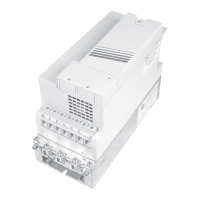Seite 3.4 - 6 COMBIVERT R6-S © KEB, 2008-02
Digital in- and outputs
3.4.5 Digital noise lter (di.03)
Thedigitalnoiselterreducesthesensitivityagainstdisturbancesatthedigitalinputs.Onlyhardwareinputs
canbeltered.Eachinputhasaseparateltercounter,whichcountsupwardatactiveinputanddownwardat
inactiveinput.Theoutputofthelterissetonreachingtheltertimeandresetwhenreaching zero.
Parameter Setting range Resolution
di.03 0...127 ms 1 ms
Priorityoftheltertimes:thehighertimeisused.
3.4.6 Invert the inputs (di.04)
With parameter di.04 can be adjusted whether a signal is 1- or 0- active (inverted). The parameter is bit-coded,
i.e. the appropriate value of the input must be entered. If several inputs shall be inverted, the sum is to be for-
med(Exception:invertingofthecontrolreleaseremainswithoutfunction).
3.4.7 Input trigger (di.05)
As standard the COMBIVERT is controlled with static signals i.e., an input is set as long as a signal is active.
But in practice it may happen that a signal is only available temporary, but the input shall remain set. For this
case this or several inputs can be set to input trigger. A rising slope with a pulse duration, which is longer than
theresponsetimeofthedigitallteris sufcientforswitchingon.Switchingoffisdonewiththenextrisingslo-
pe.
Control release (ST) can be adjusted to input trigger, but this has no effect to the function, since this is a static
signal.
Picture3.4.7Exampleofasignalowdiagramforinput(di.05 = 16)
Slope-triggering
Input trigger
3.4.8 Strobe-dependent inputs (di.06, di.07, di.08)
A strobe signal is mainly used for triggering the input signals. For example, two inputs are used for parameter
set selection. The incoming signals to the control are not simultaneously, so that it would be switched into an
unwanted set for a short-time. For active strobe (scanning signal) the actual input signals of the strobe-depen-
dent inputs are stored and have been retained to the next scanning.

